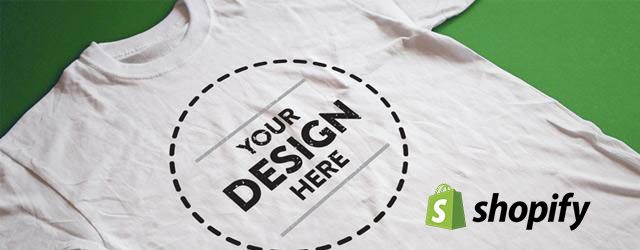Got an idea that would be great for a t-shirt store but don’t know how to get started? Or do you already run a store and need help managing your orders? Dropshipping just might be the answer for you.
If you’ve ever been curious about launching a store with a dropshipper, or are curious about what that even entails, this blog post is for you. Learn about what dropshipping is and how to get started.
What is dropshipping?
Dropshipping is essentially a fulfillment method where the retailer doesn’t stock his or her own inventory. What happens is, the dropshipper buys the product from a third party and then sends it to the retailer’s end customer.
There are loads of products you can sell with dropshippers, but for the purpose of this post we’ll focus on t-shirts. In this case, your dropshipper will purchase apparel items from their suppliers, print your designs on them, and then send them off to your customers.
Why (or why not) should you partner with a dropshipper?
Ecommerce retailers big and small use dropshipping for their businesses. Here is a list of reasons why:
– No need to buy or rent expensive printing equipment
– No need to learn printing techniques
– No stocking inventory or buying it in bulk ahead of time
– Minimal losses if you launch a product that doesn’t sell well
– More time to focus on other aspects of the business
– No trips to the post office or thinking about shipping
Dropshipping is great for beginners because it’s an easy way to test the waters of ecommerce. Since you don’t have to spend money upfront on stocking products and buying equipment, you suffer minimal financial losses if it doesn’t work out. For bigger retailers, it’s nice to get help fulfilling large quantities of orders and testing new designs.
And if you just want to start an online store as a side project, dropshipping is ideal. You get to spend whatever time you have thinking about the fun stuff while the grunt work is taken care of.
That sounds too good to be true…
Of course, dropshipping isn’t perfect. Since there’s such a low barrier to entry, you’ll be facing a lot of competition to get momentum. Here are some other downsides:

Source: Pixabay
– Lower profit margins
– Quality is beyond your control
– Limited customization for your orders
So how do you know what’s right?
Consider all of the pros and cons and decide what your priorities are.
Maybe you want the help of a dropshipper to validate new design ideas before fulfilling them yourself. Or maybe you’re already selling such high volumes that you just don’t want the hassle of fulfilling them. Or maybe what you want above all is convenience.
Either way, if you decide to go the dropshipping route, it’s easy to try it out before committing. This next section covers how you can move forward with partnering with a dropshipper.
Decisions, decisions: how do you decide on a dropshipper?

Source: Pixabay
You have a lot of dropshippers to choose from, so it can be overwhelming to know which is the best one. What will ultimately help you decide is getting a feel for each service. Is it easy to get a hold of them? Is their support staff helpful? Are their products and printing good quality? Here are some practical things you should consider:
1. Communicating with their support team
You need to understand whether you like working with them. Are they available by email, phone, live chat? Are they friendly and helpful? You should also understand how to communicate with them about your customers.
They’ll help you support your own customer support, so you should know how they handle problems. How long does it take to replace damaged products? What is their return policy?
2. What are their fulfillment times?
What’s the average amount of time it takes for the product to go from order to the end customer? In today’s age of Amazon, online shoppers expect to get their online swag fast. Will your dropshipper deliver?
3. What are their shipping options?
What carriers do they offer? Do they offer cheaper options, and expedited shipping with tracking? Your customers should have a variety of options.
4. Are they white label?
White label means they don’t show their branding anywhere on your packages; it looks like orders are going straight from you to your customers.
Some dropshippers even offer more branding options to customise your orders. For example, Printful lets you add your logo to the shipping labels on the outside of your packages. And they let you add promotional materials and other pack-ins to your orders.
5. Which products do they offer?
Some dropshippers offer more selection than others. Take a look at the quality and price to see if there’s something you’re happy with.
6. Do they offer samples?
It is critical that you order products for yourself – you need to stand by the quality and know what your customers are getting. So it’s a good idea to find a dropshipper that offers discounted samples.
7. Are they compatible with your store’s platform?
The whole idea of dropshipping is for you to save time. So it would be extra beneficial for you if you used a dropshipper that integrates directly with your store. That way orders can become automatically fulfilled.
What you ultimately need is to make sure your dropshipper is a company you can work with in terms of communication, extra services they offer, price, and product quality.
Printful covers all of these bases: their support is reachable by phone, chat, and email and they’re seriously friendly. They offer a variety of options when it comes to shipping, product choice, branding options, and ecommerce integrations.
Setting up and maintaining your store
The process of setting up will be different for each dropshipper. But these are some universal tasks you’ll have to take care of:
– Picking your storefront if you don’t have one already – you have a lot of options here too, like Shopify or WooCommerce
– Setting up a payment processor
– Getting familiar with your dropshipper’s design guidelines
– Setting your prices and profit margins
And as much as dropshipping makes your life easier as an online retailer, you can’t just set it and forget it. These are some of the tasks you’ll have to keep track of to keep your store running:
– Checking up on orders and making sure they’re going through
– Managing your customer support
– Marketing your store and products
– Writing product descriptions and taking photos of your products
At the end of the day, this is still your store and your brand behind it. So keep up with what’s going on and actively work to promote it. And if you find a dropshipper that’s right for you, the workload will be a lot easier to manage.
Written by Sergiu
Hi, I'm Sergiu. I run TeeHunter. I make sure our team of t-shirt addicts have everything they need to bring you the best t-shirts out there.





